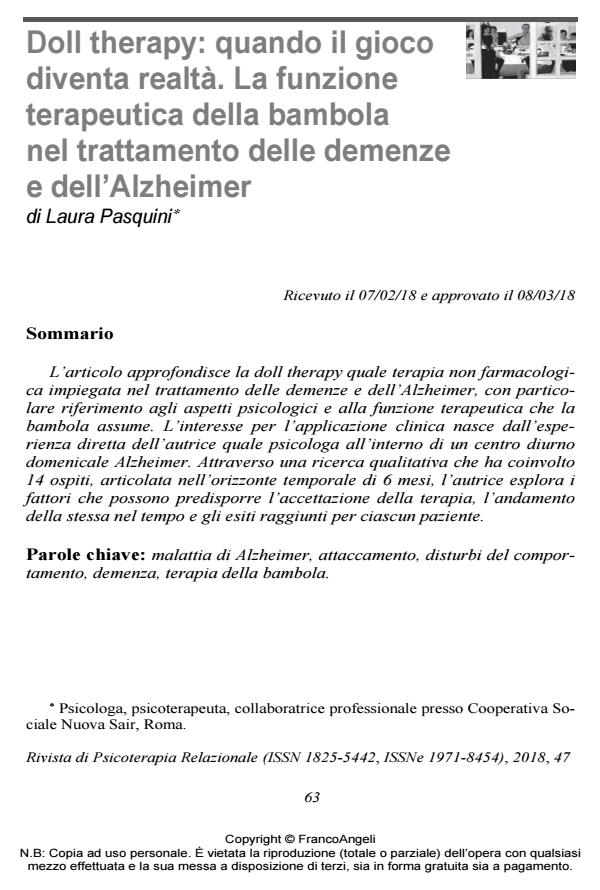Doll Therapy: when the game becomes reality. The therapeutic function of the doll in the treatment of dementia and Alzheimer’s disease
Journal title RIVISTA DI PSICOTERAPIA RELAZIONALE
Author/s Laura Pasquini
Publishing Year 2018 Issue 2018/47
Language Italian Pages 16 P. 63-78 File size 219 KB
DOI 10.3280/PR2018-047005
DOI is like a bar code for intellectual property: to have more infomation
click here
Below, you can see the article first page
If you want to buy this article in PDF format, you can do it, following the instructions to buy download credits

FrancoAngeli is member of Publishers International Linking Association, Inc (PILA), a not-for-profit association which run the CrossRef service enabling links to and from online scholarly content.
The article explores doll therapy as a non-pharmacological therapy adopted in the treatment of dementia and Alzheimer’s disease, with particular reference to the psychological aspects and to the therapeutic function of the doll. Interest in the clinical application stems from the direct experience of the author as a psychologist in a Sunday Alzheimer Day Care Center. The author explores which factors can predispose to the therapy acceptance, the course of therapy over time, and the outcomes achieved for each patients, through a qualitative research that involved 14 patients over 6 months.
Keywords: Alzheimer’s disease, attachment, behavioral problems, dementia, doll therapy.
- Bateson G. (1976). Verso un’ecologia della mente. Adelphi: Milano.
- Bisiani L., Angus, J. (2012). Doll therapy: a therapeutic means to meet past attachment needs and diminish behaviours of concern in a person living with dementia-a case study approach. Dementia (London, England), 12(4): 447-62. DOI: 10.1177/1471301211431362
- Bowlby J. (1972). Attaccamento e perdita, Vol.1. Bollati Boringhieri: Torino.
- Bowlby J. (1982). Costruzione e rottura dei legami affettivi. Raffaello Cortina: Milano.
- Bowlby J. (1989). Una base sicura. Applicazioni cliniche della teoria dell’at taccamento. Raffaello Cortina: Milano.
- Cilesi I. (2009). Alleviare le tensioni: Come favorire lo star bene con una bambola. Assistenza anziani, Mag. 55-59 -- testo disponibile al sito: http://studylibit.com/ doc/4939150/alleviare-le-tensioni (10.11.2017)
- Cilesi I. (2011). Terapia della bambola. Farmaci e argive: test sulla validità. Assistenza anziani, Mag; 41-43 -- testo disponibile al sito: http://studylibit.com/doc/7562791/sperimentazioni (10.11.2017)
- James I.A., Mackenzie L., Mukaetova Ladinska E. (2006). Doll use in care homes for people with dementia. International journal of geriatric psychiatry, 21(11): 1093-1098.
- Lupoi S., Corsello A., Pedi S. (2013). Curare giocando, giocare curando. FrancoAngeli: Milano.
- Mackenzie L., James I.A., Morse R., Mukaetova-Ladinska E., Reichelt F.K. (2006a). A pilot study on the use of dolls for people with dementia. Age and ageing, 35(4): 441-444.
- Mitchell G., Templeton M. (2014). Ethical considerations of doll therapy for people with dementia. Nursing ethics, 21(6): 720-730.
- Pezzati R., Molteni V., Bani M., Settanta C., Di Maggio M.G., Villa I., Ardito R. B. (2014). Can Doll therapy preserve or promote attachment in people with cognitive, behavioral, and emotional problems? A pilot study in institutionalized patients with dementia. Frontiers in psychology, 5(APR): 1-9.
- Watzlawick P., Beavin J.H., Jackson D. (1971). Pragmatica della comunicazione umana. Astrolabio: Roma.
- Winnicott D.W. (2004). Psicoanalisi dello sviluppo. Brani scelti. Armando: Roma.
Laura Pasquini, Doll therapy: quando il gioco diventa realtà. La funzione terapeutica della bambola nel trattamento delle demenze e dell’Alzheimer in "RIVISTA DI PSICOTERAPIA RELAZIONALE " 47/2018, pp 63-78, DOI: 10.3280/PR2018-047005